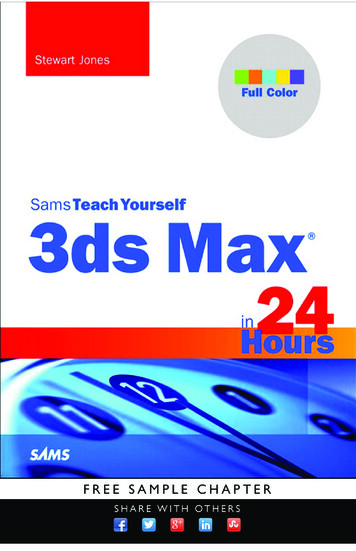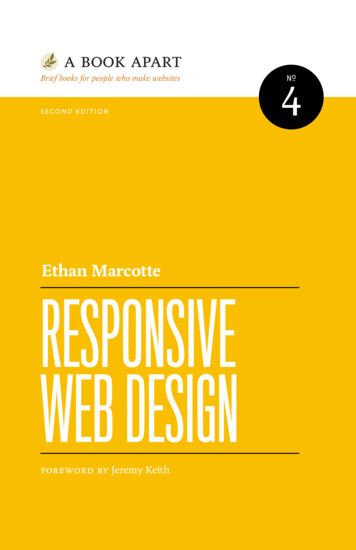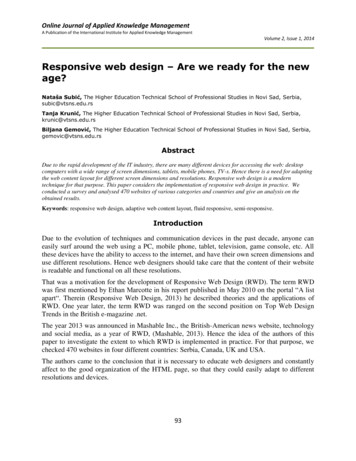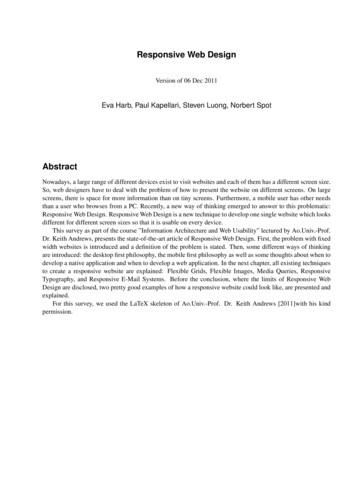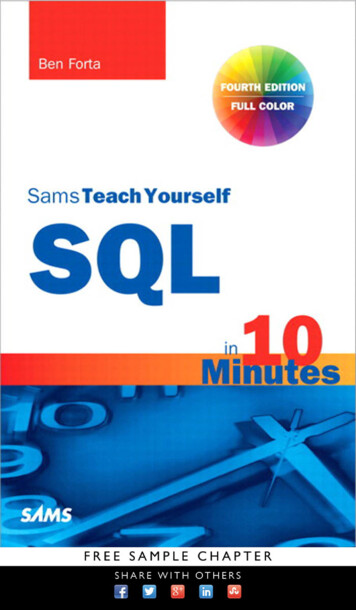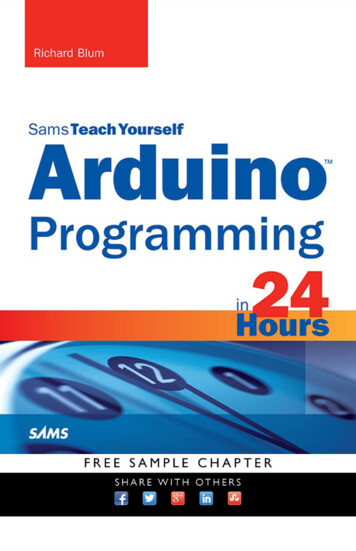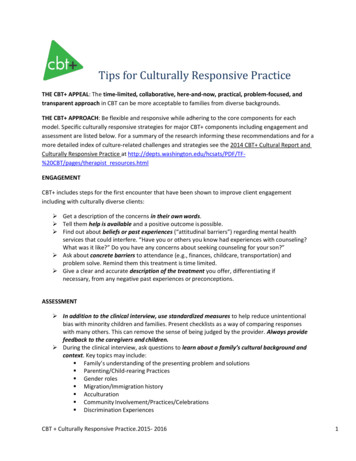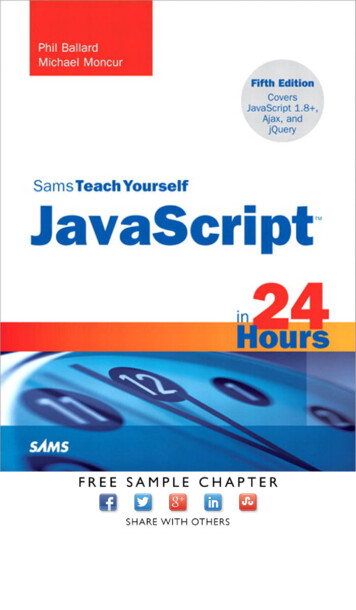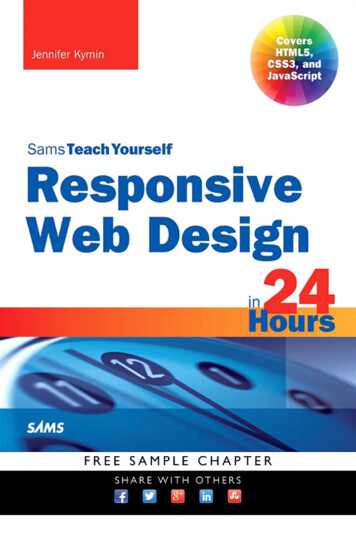
Transcription
Jennifer KyrninSamsTeachYourselfResponsiveWeb Design24Hoursin800 East 96th Street, Indianapolis, Indiana, 46240 USA
Sams Teach Yourself Responsive Web Design in 24 HoursCopyright 2015 by Pearson EducationAll rights reserved. No part of this book shall be reproduced, stored in a retrievalsystem, or transmitted by any means, electronic, mechanical, photocopying, recording, orotherwise, without written permission from the publisher. No patent liability is assumedwith respect to the use of the information contained herein. Although every precautionhas been taken in the preparation of this book, the publisher and author assume noresponsibility for errors or omissions. Nor is any liability assumed for damages resultingfrom the use of the information contained herein.ISBN-13: 978-0-672-33838-0ISBN-10: 0-672-33838-6Library of Congress Control Number: 2014919261Printed in the United States of AmericaFirst Printing: November 2014TrademarksAll terms mentioned in this book that are known to be trademarks or service marks havebeen appropriately capitalized. Sams Publishing cannot attest to the accuracy of thisinformation. Use of a term in this book should not be regarded as affecting the validity ofany trademark or service mark.Warning and DisclaimerEvery effort has been made to make this book as complete and as accurate as possible,but no warranty or fitness is implied. The information provided is on an “as is” basis. Theauthor and the publisher shall have neither liability nor responsibility to any person orentity with respect to any loss or damages arising from the information contained in thisbook or from the use of the CD or programs accompanying it.Special SalesFor information about buying this title in bulk quantities, or for special sales opportunities(which may include electronic versions; custom cover designs; and content particular toyour business, training goals, marketing focus, or branding interests), please contact ourcorporate sales department at corpsales@pearsoned.com or (800) 382-3419.For government sales inquiries, please contact governmentsales@pearsoned.com.For questions about sales outside the U.S., please contact international@pearsoned.com.Acquisitions EditorMark TaberManaging EditorSandra SchroederProject EditorSeth KerneyCopy EditorKitty WilsonIndexerKen JohnsonProofreaderKathy RuizTechnical EditorJon MorinPublishing CoordinatorVanessa EvansDesignerGary AdairPage LayoutBronkella Publishing,LLC
ContentsIntroduction1Making Your Site “Every Device” Friendly . . . . . . . . 1How to Use This Book . . . . . . . . . . . . . . . . . . . . . . . . . . . . . . . . 1PART I INTRODUCTION TO RESPONSIVE DESIGNHOUR 1: What Is Responsive Web Design? 5History of Responsive Web Design. . . . . . . . . . . . . . . . . 5Why We Need Responsive Web Design . . . . . . . . . . 11Summary . . . . . . . . . . . . . . . . . . . . . . . . . . . . . . . . . . . . . . . . . . . . . . . . 12Workshop . . . . . . . . . . . . . . . . . . . . . . . . . . . . . . . . . . . . . . . . . . . . . . . 13HOUR 2: Alternatives to Responsive WebDesign15Styling Fonts and Colors . . . . . . . . . . . . . . . . . . . . . . . . . . . . 78Creating a Layout with CSS . . . . . . . . . . . . . . . . . . . . . . . . . 83Understanding Cascading and Specificity. . . . . . . . 88Summary . . . . . . . . . . . . . . . . . . . . . . . . . . . . . . . . . . . . . . . . . . . . . . . . 90Workshop . . . . . . . . . . . . . . . . . . . . . . . . . . . . . . . . . . . . . . . . . . . . . . . 9295HOUR 7: Unobtrusive JavaScriptWhat Is Unobtrusive JavaScript? . . . . . . . . . . . . . . . . . . 95How to Implement Unobtrusive JavaScript . . . . . . 98Summary . . . . . . . . . . . . . . . . . . . . . . . . . . . . . . . . . . . . . . . . . . . . . . 101Workshop . . . . . . . . . . . . . . . . . . . . . . . . . . . . . . . . . . . . . . . . . . . . . 102PART II BUILDING A RESPONSIVE WEBSITETable-Based Layouts . . . . . . . . . . . . . . . . . . . . . . . . . . . . . . . . . 15CSS Layouts . . . . . . . . . . . . . . . . . . . . . . . . . . . . . . . . . . . . . . . . . . . 21Detection Scripts. . . . . . . . . . . . . . . . . . . . . . . . . . . . . . . . . . . . . . 30Summary . . . . . . . . . . . . . . . . . . . . . . . . . . . . . . . . . . . . . . . . . . . . . . . . 32Workshop . . . . . . . . . . . . . . . . . . . . . . . . . . . . . . . . . . . . . . . . . . . . . . . 35HOUR 8: Planning a Responsive Website 105Should You Make Your Website Responsive? . 106How to Plan for a Responsive Website. . . . . . . . . 107Summary . . . . . . . . . . . . . . . . . . . . . . . . . . . . . . . . . . . . . . . . . . . . . . 112Workshop . . . . . . . . . . . . . . . . . . . . . . . . . . . . . . . . . . . . . . . . . . . . . 11337HOUR 3: The Growth of MobileBasic Cell Phones . . . . . . . . . . . . . . . . . . . . . . . . . . . . . . . . . . . . 37Smartphones. . . . . . . . . . . . . . . . . . . . . . . . . . . . . . . . . . . . . . . . . . . 39Tablets . . . . . . . . . . . . . . . . . . . . . . . . . . . . . . . . . . . . . . . . . . . . . . . . . . 41Retina Devices . . . . . . . . . . . . . . . . . . . . . . . . . . . . . . . . . . . . . . . . 42Why Responsive Design Is Important . . . . . . . . . . . . . 44Summary . . . . . . . . . . . . . . . . . . . . . . . . . . . . . . . . . . . . . . . . . . . . . . . . 44Workshop . . . . . . . . . . . . . . . . . . . . . . . . . . . . . . . . . . . . . . . . . . . . . . . 45115HOUR 9: Mobile FirstWhy Design for Mobile First? . . . . . . . . . . . . . . . . . . . . . 115What Makes a Site Mobile Friendly? . . . . . . . . . . . 118What About Mobile Only? . . . . . . . . . . . . . . . . . . . . . . . . . 121Summary . . . . . . . . . . . . . . . . . . . . . . . . . . . . . . . . . . . . . . . . . . . . . . 121Workshop . . . . . . . . . . . . . . . . . . . . . . . . . . . . . . . . . . . . . . . . . . . . . 12347HOUR 4: Progressive EnhancementWhat Is Progressive Enhancement? . . . . . . . . . . . . . . 47How to Use Progressive Enhancement on aWebsite . . . . . . . . . . . . . . . . . . . . . . . . . . . . . . . . . . . . . . . . . . . . . . . . . 48Benefits of Progressive Enhancement . . . . . . . . . . . . 50Summary . . . . . . . . . . . . . . . . . . . . . . . . . . . . . . . . . . . . . . . . . . . . . . . . 51Workshop . . . . . . . . . . . . . . . . . . . . . . . . . . . . . . . . . . . . . . . . . . . . . . . 52HOUR 5: HTML for Responsive WebDesign55Using HTML5. . . . . . . . . . . . . . . . . . . . . . . . . . . . . . . . . . . . . . . . . . . 55Clean Code . . . . . . . . . . . . . . . . . . . . . . . . . . . . . . . . . . . . . . . . . . . . . 62Don’t Forget Semantic Elements . . . . . . . . . . . . . . . . . . 63Validating Your HTML . . . . . . . . . . . . . . . . . . . . . . . . . . . . . . . . 67Summary . . . . . . . . . . . . . . . . . . . . . . . . . . . . . . . . . . . . . . . . . . . . . . . . 68Workshop . . . . . . . . . . . . . . . . . . . . . . . . . . . . . . . . . . . . . . . . . . . . . . . 7073HOUR 6: Basic CSSHow to Write CSS Rules . . . . . . . . . . . . . . . . . . . . . . . . . . . . . 73Embedded and External Style Sheets . . . . . . . . . . . . 76125HOUR 10: CSS Media QueriesWhat Is a Media Query? . . . . . . . . . . . . . . . . . . . . . . . . . . . 125Media Query Expressions . . . . . . . . . . . . . . . . . . . . . . . . . 129Summary . . . . . . . . . . . . . . . . . . . . . . . . . . . . . . . . . . . . . . . . . . . . . . 130Workshop . . . . . . . . . . . . . . . . . . . . . . . . . . . . . . . . . . . . . . . . . . . . . 132135HOUR 11: BreakpointsWhat Is a Breakpoint? . . . . . . . . . . . . . . . . . . . . . . . . . . . . . 135How to Define Breakpoints in CSS . . . . . . . . . . . . . . 136Optimal Breakpoints. . . . . . . . . . . . . . . . . . . . . . . . . . . . . . . . 141Summary . . . . . . . . . . . . . . . . . . . . . . . . . . . . . . . . . . . . . . . . . . . . . . 144Workshop . . . . . . . . . . . . . . . . . . . . . . . . . . . . . . . . . . . . . . . . . . . . . 145147HOUR 12: LayoutWhat Is Web Layout?. . . . . . . . . . . . . . . . . . . . . . . . . . . . . . . 147Types of Layouts . . . . . . . . . . . . . . . . . . . . . . . . . . . . . . . . . . . . 149Columns in Layout . . . . . . . . . . . . . . . . . . . . . . . . . . . . . . . . . . 158Summary . . . . . . . . . . . . . . . . . . . . . . . . . . . . . . . . . . . . . . . . . . . . . . 162Workshop . . . . . . . . . . . . . . . . . . . . . . . . . . . . . . . . . . . . . . . . . . . . . 164165HOUR 13: NavigationWhy Responsive Navigation Is Important . . . . . . 165
What Makes Navigation Mobile Friendly? . . . . . . 166Basic RWD Navigation Patterns . . . . . . . . . . . . . . . . . . 168Summary . . . . . . . . . . . . . . . . . . . . . . . . . . . . . . . . . . . . . . . . . . . . . . 179Workshop . . . . . . . . . . . . . . . . . . . . . . . . . . . . . . . . . . . . . . . . . . . . . 180HOUR 14: Responsive Fonts andTypography183Using Web Fonts . . . . . . . . . . . . . . . . . . . . . . . . . . . . . . . . . . . . 183Sizing Typography . . . . . . . . . . . . . . . . . . . . . . . . . . . . . . . . . . . 187Relative Versus Absolute Font Sizes. . . . . . . . . . . . 193New CSS3 Measurement Units . . . . . . . . . . . . . . . . . . 195Summary . . . . . . . . . . . . . . . . . . . . . . . . . . . . . . . . . . . . . . . . . . . . . . 196Workshop . . . . . . . . . . . . . . . . . . . . . . . . . . . . . . . . . . . . . . . . . . . . . 197HOUR 15: Creating and Using Imagesin RWD199Making Images Responsive. . . . . . . . . . . . . . . . . . . . . . . 199Improving Download Speeds . . . . . . . . . . . . . . . . . . . . . 207Building and Using Retina-Ready Images . . . . . . 207Summary . . . . . . . . . . . . . . . . . . . . . . . . . . . . . . . . . . . . . . . . . . . . . . 211Workshop . . . . . . . . . . . . . . . . . . . . . . . . . . . . . . . . . . . . . . . . . . . . . 212HOUR 16: Videos and Other Mediain RWD215How to Make Videos Responsive. . . . . . . . . . . . . . . . 215Making YouTube Videos Responsive . . . . . . . . . . . 219Summary . . . . . . . . . . . . . . . . . . . . . . . . . . . . . . . . . . . . . . . . . . . . . . 221Workshop . . . . . . . . . . . . . . . . . . . . . . . . . . . . . . . . . . . . . . . . . . . . . 222HOUR 17: Tables in Responsive WebDesign225Tables on Small Devices . . . . . . . . . . . . . . . . . . . . . . . . . . 225Can Tables Be Responsive? . . . . . . . . . . . . . . . . . . . . . . 226Where Do Layout Tables Fit in RWD?. . . . . . . . . . . 236Summary . . . . . . . . . . . . . . . . . . . . . . . . . . . . . . . . . . . . . . . . . . . . . . 240Workshop . . . . . . . . . . . . . . . . . . . . . . . . . . . . . . . . . . . . . . . . . . . . . 241245HOUR 18: Responsive Web FormsHTML5 Forms . . . . . . . . . . . . . . . . . . . . . . . . . . . . . . . . . . . . . . . . 245Making Web Forms Usable . . . . . . . . . . . . . . . . . . . . . . . 251Creating Responsive Forms . . . . . . . . . . . . . . . . . . . . . . . 254Summary . . . . . . . . . . . . . . . . . . . . . . . . . . . . . . . . . . . . . . . . . . . . . . 258Workshop . . . . . . . . . . . . . . . . . . . . . . . . . . . . . . . . . . . . . . . . . . . . . 259HOUR 19: Testing Responsive Websites 263Testing in Your Browser . . . . . . . . . . . . . . . . . . . . . . . . . . . 264Testing in a Device for All Your Breakpoints . . 266How to Test When You Don’t Have theDevices. . . . . . . . . . . . . . . . . . . . . . . . . . . . . . . . . . . . . . . . . . . . . . . . 271Summary . . . . . . . . . . . . . . . . . . . . . . . . . . . . . . . . . . . . . . . . . . . . . . 273Workshop . . . . . . . . . . . . . . . . . . . . . . . . . . . . . . . . . . . . . . . . . . . . . 274HOUR 20: Problems with ResponsiveWeb Design277Responsive Designs Can Be Slow . . . . . . . . . . . . . . 277RWD Can Make More Work for Designers . . . . . 280Not All Customers Like Responsive Sites . . . . . 282RWD May Break Advertising . . . . . . . . . . . . . . . . . . . . . . 283Summary . . . . . . . . . . . . . . . . . . . . . . . . . . . . . . . . . . . . . . . . . . . . . . 286Workshop . . . . . . . . . . . . . . . . . . . . . . . . . . . . . . . . . . . . . . . . . . . . . 287PART III IMPROVING ON RESPONSIVE WEBDESIGNHOUR 21: Tools for Creating ResponsiveWeb Designs291Planning and Designing Your RWD Site . . . . . . . . 291HTML Element and CSS Tools . . . . . . . . . . . . . . . . . . . 295Web Editors for Building ResponsiveWeb Pages . . . . . . . . . . . . . . . . . . . . . . . . . . . . . . . . . . . . . . . . . . . 302Summary . . . . . . . . . . . . . . . . . . . . . . . . . . . . . . . . . . . . . . . . . . . . . . 303Workshop . . . . . . . . . . . . . . . . . . . . . . . . . . . . . . . . . . . . . . . . . . . . . 304HOUR 22: Device and Feature Detection 307Why Use Detection Scripts. . . . . . . . . . . . . . . . . . . . . . . . 307Modernizr . . . . . . . . . . . . . . . . . . . . . . . . . . . . . . . . . . . . . . . . . . . . . 311WURFL . . . . . . . . . . . . . . . . . . . . . . . . . . . . . . . . . . . . . . . . . . . . . . . . . 313Summary . . . . . . . . . . . . . . . . . . . . . . . . . . . . . . . . . . . . . . . . . . . . . . 315Workshop . . . . . . . . . . . . . . . . . . . . . . . . . . . . . . . . . . . . . . . . . . . . . 316319HOUR 23: Using RESS with RWDWhat Is RESS? . . . . . . . . . . . . . . . . . . . . . . . . . . . . . . . . . . . . . . 319Benefits of Using RESS. . . . . . . . . . . . . . . . . . . . . . . . . . . . 320Getting Started with RESS . . . . . . . . . . . . . . . . . . . . . . . . 320When to Use RESS . . . . . . . . . . . . . . . . . . . . . . . . . . . . . . . . . 328Summary . . . . . . . . . . . . . . . . . . . . . . . . . . . . . . . . . . . . . . . . . . . . . . 330Workshop . . . . . . . . . . . . . . . . . . . . . . . . . . . . . . . . . . . . . . . . . . . . . 331333HOUR 24: RWD Best PracticesGive Everyone the Best Experience . . . . . . . . . . . . . 334Use the Best Breakpoints You Can . . . . . . . . . . . . . 336Be Flexible and Think Small . . . . . . . . . . . . . . . . . . . . . . 338Don’t Forget the Content . . . . . . . . . . . . . . . . . . . . . . . . . . 340Manage Costs . . . . . . . . . . . . . . . . . . . . . . . . . . . . . . . . . . . . . . 342Summary . . . . . . . . . . . . . . . . . . . . . . . . . . . . . . . . . . . . . . . . . . . . . . 344Workshop . . . . . . . . . . . . . . . . . . . . . . . . . . . . . . . . . . . . . . . . . . . . . 345Index347
About the AuthorJennifer Kyrnin has been teaching HTML, XML, and web design online since 1997. She has builtand maintained websites of all sizes, from small, single-page brochure sites to large, million-pagedatabase-driven sites for international audiences. She lives with her husband and son and numerous animals on a small farm in Washington state.DedicationTo Mark and Jaryth. This was much easier because you were around. I love you.AcknowledgmentsI would like to thank all the people at Sams Publishing for the opportunity to write this book andwork with you. I would particularly like to thank Mark Taber and Seth Kerney for keeping me movingand the book on track, as well as my fabulous technical editor, Jon Morin, and my amazing andtolerant copy editor Kitty Wilson for all the great suggestions and corrections. Any technical errorsyou find in the book are mine alone; the editors probably tried to stop me.I would also like to thank my family for putting up with me while I wrote the book, including mybrother Brendan Kirby, who was instrumental in helping me get my thoughts together on one toughsection, and the members of the Woodinville Writers Group, who were very kind in letting meinterrupt their fiction stories with some cold hard HTML.
We Want to Hear from You!As the reader of this book, you are our most important critic and commentator. We value youropinion and want to know what we’re doing right, what we could do better, what areas you’d like tosee us publish in, and any other words of wisdom you’re willing to pass our way.You can email or write to let us know what you did or didn’t like about this book—as well as whatwe can do to make our books stronger.Please note that we cannot help you with technical problems related to the topic of this book, andthat due to the high volume of mail we receive, we might not be able to reply to every message.When you write, please be sure to include this book’s title, edition number, and author, as well asyour name and contact Sams Publishing800 East 96th StreetIndianapolis, IN 46240 USAReader ServicesVisit our website and register this book at informit.com/register for convenient access to anyupdates, downloads, or errata that might be available for this book.
IntroductionResponsive web design (RWD) is a way of thinking about web pages that allows designers to work on one website for all visitors but tailor the site to the device each visitoris viewing it on. More and more companies are requiring web designers to build theirsites responsively, and knowing how to do it well will help web designers differentiatethemselves in the industry.Making Your Site “Every Device” FriendlyThis book covers more than just how and when to build CSS breakpoints to build aresponsive site. Once you’ve finished this book, you will understand all these ideas:. How the use of RWD got started and why web designers began using it instead ofother techniques. What progressive enhancement is and how important it is to RWD. Basic HTML5, CSS3, and JavaScript to build a website framework that is easy tomake responsive. How mobile devices affect responsive design and how they aren’t the whole storywhen it comes to creating responsive websites. The basics of building RWD, including media queries and breakpoints. How to make your layout, navigation, images, tables, fonts, videos, and formsresponsive. How to test your designs even if you don’t have a lot of mobile devices. The common problems in RWD and how to alleviate them. How to use RESS and other tools and technologies to improve your designs. Best practices for using RWD and building a responsive siteHow to Use This BookThis book is divided into 24 lessons, called “hours.” Each lesson covers a specific topicrelated to building responsive web pages using responsive web design. Each lessontakes about an hour to complete.
2Organization of This BookThe book is divided into three sections:. Part I, “Introduction to Responsive Design,” introduces you to RWD and explainsthe basic HTML, CSS, and JavaScript you need to know. Part II, “Building a Responsive Website,” addresses specific aspects of RWD, suchas navigation, images, and tables, and shows you how to make them responsive. Part III, “Improving on Responsive Web Design,” introduces you to some toolsand techniques you can use to improve your RWD and describes problems youmay have as well as best practices in the field.Conventions Used in This BookCode samples are written in monospaced font within the text of the book, while blocksof code appear separately, like this:This is a blockOf codeSome code samples that are too long to display as one line in the book use the symbol to indicate that these lines should be all on one line, like this: link rel "stylesheet" href "styles-320.css" media "only screen and (max-width:320px)" This book has three types of sidebars:NOTETIPCAUTIONNotes provide additional information about the topics thatare discussed in the hour.Tips share interesting facts ortidbits about the related content.Cautions alert you to thingsthat can cause problems foryour web designs.You can also use the Try It Yourself sections to practice what you’ve learned in thehour. TRY IT YOURSELFTry It YourselfNearly every hour has at least one step-by-step tutorial called “Try It Yourself”to help you use what you’ve learned.
IntroductionQ&A, Quiz, and ExercisesEvery hour ends with a short question-and-answer section that anticipates follow-upquestions you may have after reading the hour. You can also take a short quiz onwhat you’ve learned as well as do some suggested exercises to help you get more out ofwhat you learned and apply your new knowledge to your own web designs.Where to Go to Learn MoreThis book has a companion website at http://html5in24hours.com, where you can goto see the examples, view and download the source code, view and report errata aboutthe book, and continue to learn and ask questions about RWD. You can also findJennifer Kyrnin online at http://htmljenn.com, and she welcomes questions and comments.3
This page intentionally left blank
HOUR 5HTML for Responsive Web DesignResponsive web design doesn’t add any new HTML tags or attributes:You simply write your HTML so that it is well-formed, valid, andsemantic.The best responsive sites are sites that also use progressive enhancement, as you learned in Hour 4, “Progressive Enhancement.” Thesesites keep the HTML, CSS, and JavaScript separate so that the pagesare easier to maintain and load more quickly.In this hour you will learn the basics of HTML so that you can puttogether a decent website and make it responsive. However, there ismore to HTML than you can learn in just one hour, so if you don’tknow HTML at all, you should consider a book like Sams Teach YourselfHTML and CSS in 24 Hours by Julie C. Meloni.Using HTML5HTML5 is the most recent version of HTML and provides the mostassistance to web designers who want to use progressive enhancementand RWD. While you can build RWD sites using other versions ofHTML, it’s best to stay as up-to-date as possible. This book uses HTML5code samples.Tags Every Page Should ContainThere are several HTML tags that every web page should contain. Thesetags may not be required for valid HTML, but they provide informationWHAT YOU’LL LEARN INTHIS HOUR:. How to write HTML for RWD. How to build a basic webpage with HTML5. What semantic elementsare and how to use them. Why valid HTML is important
56HOUR 5: HTML for Responsive Web Designabout the page to the browser to make them easier to use. Every webpage should contain these tags:. !doctype . html . head . meta charset . title . body If your web page contains these elements, it contains the minimum HTMLrequired to start building a responsive page. Listing 5.1 provides a standard template you can use to start any web page. Note that the tags listedabove have both starting and ending tags as well as some attributes.LISTING 5.1A Basic HTML Template !doctype html html head meta charset "UTF-8" title Untitled Document /title /head body /body /html TIPHTML Is Not CaseSensitiveIn the past, it was very commonto see doctype definitions written in all uppercase, but that isno longer required. In fact, allparts of HTML can be writtenin upper-, lower-, or even mixedcase. The tag html is thesame as HTML and HtMl .But the convention is to use alllowercase.The first line in the code is the doctype. The doctype !doctype html tells the browser that this is HTML5.Then you place the opening html tag. Be sure to surround the entiredocument with this element by including the /html tag at the veryend. This tells the browser that this is an HTML document, and also ittells the browser where it should expect to see HTML tags.Valid HTML keeps all the content inside the html and /html tags,but if content slips out, the browser will still parse it. Some contentmanagement systems append content to the top or bottom of theHTML, without placing it inside these tags. This content will still beparsed and displayed by browsers, but it could cause problems. Keepyour content inside the html and /html tags, and you’ll be safe.The head and /head tags contain details about the web page thatmay not be visible to the browser—things like metadata, the title, and
Using HTML5any links to CSS and JavaScript. The basic template in Listing 5.1includes a meta charset tag and a title tag.The meta charset tag is an important one for keeping your webpages secure. It should always be the very first tag in the head of yourHTML documents. It tells the browser what character set the page uses.If you don’t define the character set, or if you define it later in thedocument, you open up your site to hackers who can manipulate thecharacter set and inject malicious code into the site.Once you’ve defined the head information of your document, all youhave left is the body element. This is where all the visible contentgoes. It contains what most people consider the meat of the web page.Anything that you type inside the body and /body tags will showin the browser window.Basic Tags for Web ContentWhile the tags already listed in this lesson are all you need to create awebsite, the site would be very plain and hard to read if you used onlythese tags. While there are dozens of HTML tags you can use (I list thenew HTML5 elements at ments/), there are only a few you need to know about to startcreating a decent web page:. h1 , h2 , and h3 . p and br . a . strong and em . img , audio , and video Most web pages start with a headline, and in HTML you use the headline tags h1 , h2 , and h3 to define them. They are numbered, andyou should use them in order, with h1 first through h6 last. Mostsites don’t go more than two or three levels deep, so you really onlyneed to know h2 and h3 .Once you have a headline, you can start adding content in paragraphsby using the p tag. Browsers typically display a paragraph as a blockof text separated by some space. But if you want to drop down just oneline of text, you use the br tag. This is a singleton tag and does notrequire a closing tag. You will sometimes see it written as br/ , withthe additional slash. This is a remnant from XHTML. You don’t needthe closing slash, and most browsers recognize the tag either way.57
58HOUR 5: HTML for Responsive Web DesignCAUTIONYou can put these tags together to create a web page. Figure 5.1 showshow a simple web page would look, and Listing 5.2 is the HTML forcreating that web page. As you can see, the HTML is still very plain.But because content is the most important part of your website, youneed to make sure it is visible and correct first.Keep Your Tags ClosedSeveral HTML elements don’trequire closing tags, like the p element for paragraphs.While the closing /p is notrequired, it’s a good idea to useit anyway. This helps keep yourHTML clean and prevents lesscompliant browsers from gettingconfused. It’s a small price topay to ensure that your contentis seen by the largest number ofpeople.The a tag provides a link to another document. You define a link byusing the href "" attribute. Then any text or image that is inside the a element will be clickable in the browser and will take the customerto the new location.The strong and em tags let you provide some emphasis to the textin your paragraphs. In most browsers the strong tag makes the textbold and em makes the text italic. But you will be able to define howyou want those to display in your style sheets. You’ll learn more aboutthat in Hour 6, “Basic CSS.”The last three tags let you add multimedia into your web pages. The img tag adds an image to the page, using the src "" attribute to definethe location of the image on your web server. You can add sound files byusing the audio tag and videos by using the video tag. I cover thesein more detail in Hour 16, “Videos and Other Media in RWD.”FIGURE 5.1A simple web page with content.
Using HTML5LISTING 5.2Adding Some Content to the Template !doctype html html head meta charset "UTF-8" title Dandylions /title /head body h1 Dandylions /h1 h2 Not Your Mother's Weed /h2 p strong em Taraxacum /em /strong em /t 'ræks kum/ /em is a largegenus of flowering plants in the family Asteraceae. They are native toEurasia and North and South America, and two species, T. officinale andT. erythrospermum, are found as weeds worldwide. Both species are ediblein their entirety. The common name strong dandelion /strong ( em /'dændila . n/ /em dan-di-ly- n, from French dent-de-lion, meaning"lion's tooth") is given to members of the genus, and like other membersof the Asteraceae family, they have very small flowers collected togetherinto a composite flower head. Each single flower in a head is called afloret. Many em Taraxacum /em species produce seeds asexually byapomixis, where the seeds are produced without pollination, resulting inoffspring that are genetically identical to the parent plant. /p img src "images/dandy.jpg" width "400" height "300" alt ""/ p Text from a href "http://en.wikipedia.org/wiki/Dandelion" Wikipedia /a /p /body /html HTML for LayoutYou should also consider learning about some of the tags that are typically used for layout and style. There are two in particular that youshould know:. div . span These HTML tags provide no semantic meaning to your content andshould be used to add hooks for CSS and JavaScript.The div element acts like a container element, and you can placelarge blocks of text in it. It is called a block element, and most browsersadd a line both before and after, similar to a paragraph.Most people use div to create layout sections and then style thosesections with CSS. Listing 5.3 shows how you might add some sectionsto your HTML so that you can style them later.59
60HOUR 5: HTML for Responsive Web DesignLISTING 5.3HTML with Some Divisions !doctype html html head meta charset "UTF-8" title Dandylions /title /head body div id "main" h1 Dandylions /h1 div id "article" h2 Not Your Mother's Weed /h2 p strong em Taraxacum /em /strong em /t 'ræks kum/ /em is alarge genus of flowering plants in the family Asteraceae. They arenative to Eurasia and North and South America, and two species, T.officinale and T.
Responsive web design (RWD) is a way of thinking about web pages that allows design- ers to work on one website for all visitors but tai
